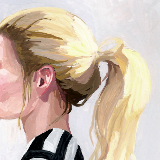The benefits of safe weight training are undeniable if you listen to your body. You shouldn’t ignore the symptoms of over-training, though. When you push yourself too far, you aren’t going to experience optimal results.
The signs of over-training are your body trying to get your attention to let you know you need to slow down. Here are some symptoms you shouldn’t ignore while you work out.
1. Sharp Elbow Pain
Working through pain while you lift weights isn’t the most intelligent way to gain muscle. While your muscles can burn in a good way, a sharp pain is typically indicative of a more serious issue. Pain in your elbow can be one of the symptoms of over-training. During biceps curls, especially, you can experience severe elbow pain from repetitive movements.
Lateral epicondylitis, or tennis elbow, occurs when you make repeated motions that cause inflammation on the outside of the elbow. Golfer’s elbow is similar to tennis elbow but appears on the inside of your elbow. You can harm your elbow even further without proper rest and diagnosis or treatment, resulting in difficulty holding or gripping light objects.
2. Groin or Hip Pain
Lunges or squat exercises can cause pain in your hip or groin area. A locking or clicking feeling can also accompany the pain and indicate a tear in the labrum. These deep pains can also come from chronic heavy lifting.
Signs of over-training your body like this can weaken your pelvic floor, causing issues with urethra support and, ultimately, stress urinary incontinence (SUI). SUI causes you to leak urine when you laugh, cough, or sneeze. You can have surgery to fix SUI or, in some cases, retrain the muscle groups with balance and stability exercises. In addition to exercise, wearing incontinence underwear can provide a safety net to avoid embarrassing leaks during the retraining process and help individuals feel more confident and comfortable as they work to strengthen their pelvic floor muscles.
3. Severe Shoulder Pain
Shoulder pain is one of the most common symptoms of over-training in the weight room. Your rotator cuff is a group of muscles and tendons that keep the ball joint centered. When you over-lift, you can strain your shoulder or harm the rotator cuff, which allows you to raise and rotate your arm. Lifting above your head while over-training, like a shoulder press or lateral raise, is a common way to injure your rotator cuff.
Not practicing safe weight training can overwork your tendons and cause them to become inflamed, resulting in tendonitis. Too many biceps curls can cause pain in the front of the shoulders. Shoulder pain while lifting weights isn’t normal nor something you should fight your way through. Pay attention to your pain and ease up on your lifting. Give your body a break and see if the pain subsides. Treat shoulder pain with over-the-counter anti-inflammatory medication and use ice to reduce swelling.
4. Radiating Back Pain
Exercise has many health benefits, but too much of anything can be a bad thing. Too much weight during squat exercises or deadlifts can cause back pain. Attempting to lift large amounts of weight with a rounded lower back can overload your spine with stress and cause damage. Relying too much on lower back muscles rather than the glutes or hamstrings can also cause back pain.
Back pain that radiates into either of your legs or experiencing numbness or tingling accompanied by back pain can indicate you’ve pinched a nerve or damaged your spine. Call your doctor to discuss your symptoms, especially if you have trouble sleeping with your back pain.
5. Side Stitches
Side stitches are muscle cramps that are common during physical activity like cardio. They’re most commonly experienced by people new to working out or who are getting back into a fitness routine. As endurance and stamina build, side stitches are likely to diminish. Side stitches usually resolve within a few moments after exercise.
However, there are instances when you should worry about them. Muscle cramps in your side can come from dehydration, not getting warmed up before a workout, or eating a large meal before you work out. If your side stitch doesn’t resolve after a few hours, especially if you’ve stopped working out, you should call your doctor. If you experience stomach pain with fever or swelling, seek emergency care.
6. Feeling Dizzy
It isn’t safe to push through your workout when you feel lightheaded or dizzy. Dehydration, heat exhaustion, or overexertion can cause you to feel faint or dizzy. Strenuous activities can cause high blood pressure, making you feel lightheaded. If you experience dizziness while you are heavy lifting, stop immediately to rest and rehydrate.
Pushing yourself too hard can cause your blood pressure to drop, making you feel faint. It’s dangerous to continue heavy lifting when you experience symptoms of over-training. You can cause severe damage to yourself and others around you.
Do not hold your breath when heavy lifting, either. Practice proper breathing to limit the stress you’re putting on your body and control lightheadedness. Exhale while you lift and inhale as you return to the starting position.
7. Chest Pain
Heavy lifting causes your heart to speed up to pump more blood to your body. It’s dangerous to overlook any chest pain, but when you’re lifting heavy weights, it can be challenging to know when to be concerned. Pain or pressure in your chest, accompanied by dizziness, palpitations, nausea, or vomiting, are heart attack symptoms. Exercise is good for your heart health, though – most heart attacks don’t happen in the gym.
Minor discomfort in your chest is typical while you’re lifting heavy weights, and so is tightness in your chest. If you have concerns about the pain in your chest, it’s best to be safe than sorry, so call your doctor to ease your mind. Overexertion can cause you to strain a muscle in your chest, resulting in sudden and sharp pain, so it’s best to follow safe weight training protocols and listen to your body while lifting weights.
Symptoms of Over-Training
Working out too hard can cause various adverse effects on your body. To achieve maximum results, you must practice safe weight training and notice when your body is hurting. Pain is your body’s way of getting your attention – so ensure you notice.
Signs of pushing yourself too hard in the weight room can range from one-sided soreness to injury from repetitive movement. Switch up your lifting routine and maintain your balance to avoid over-training.








